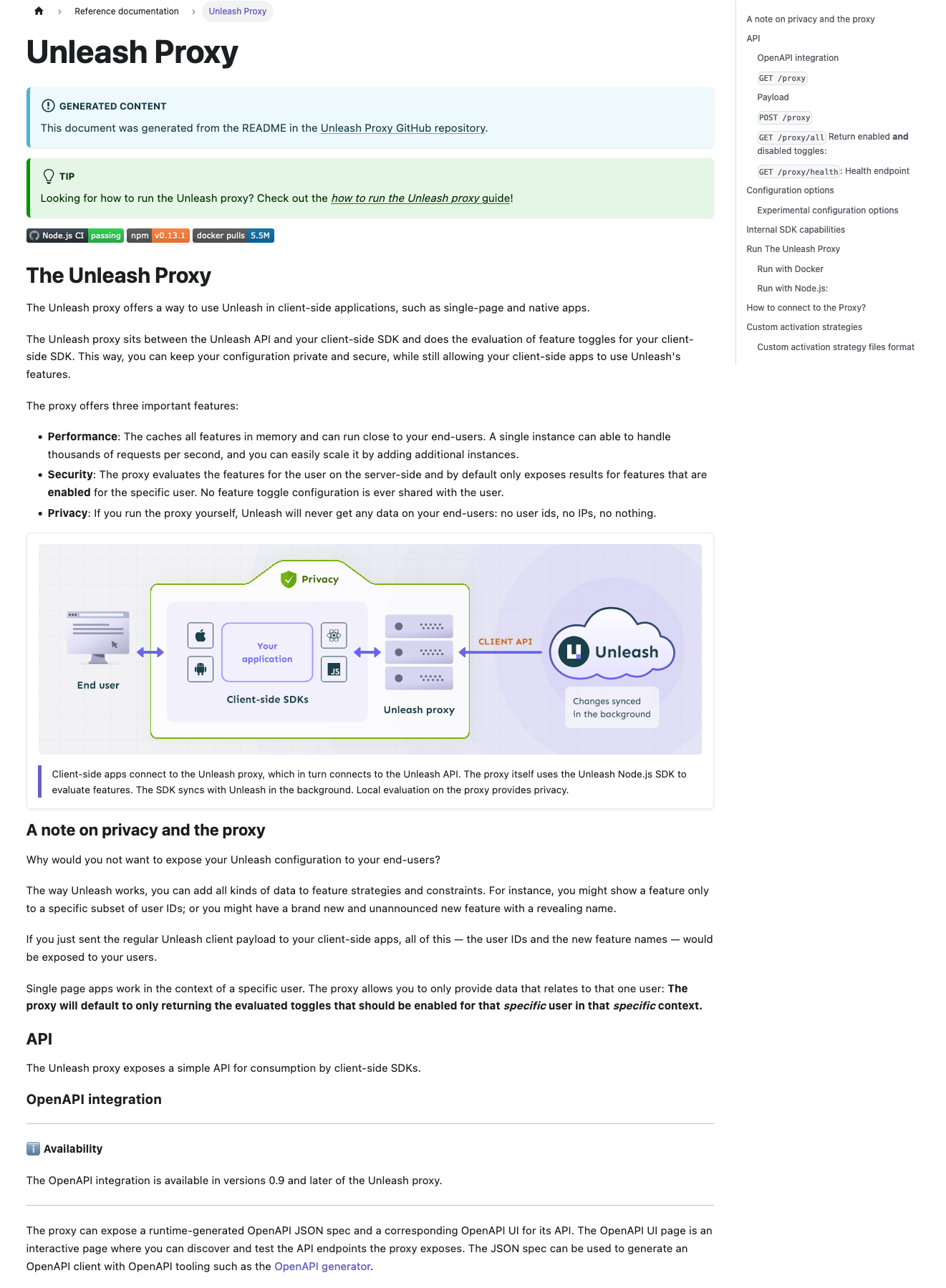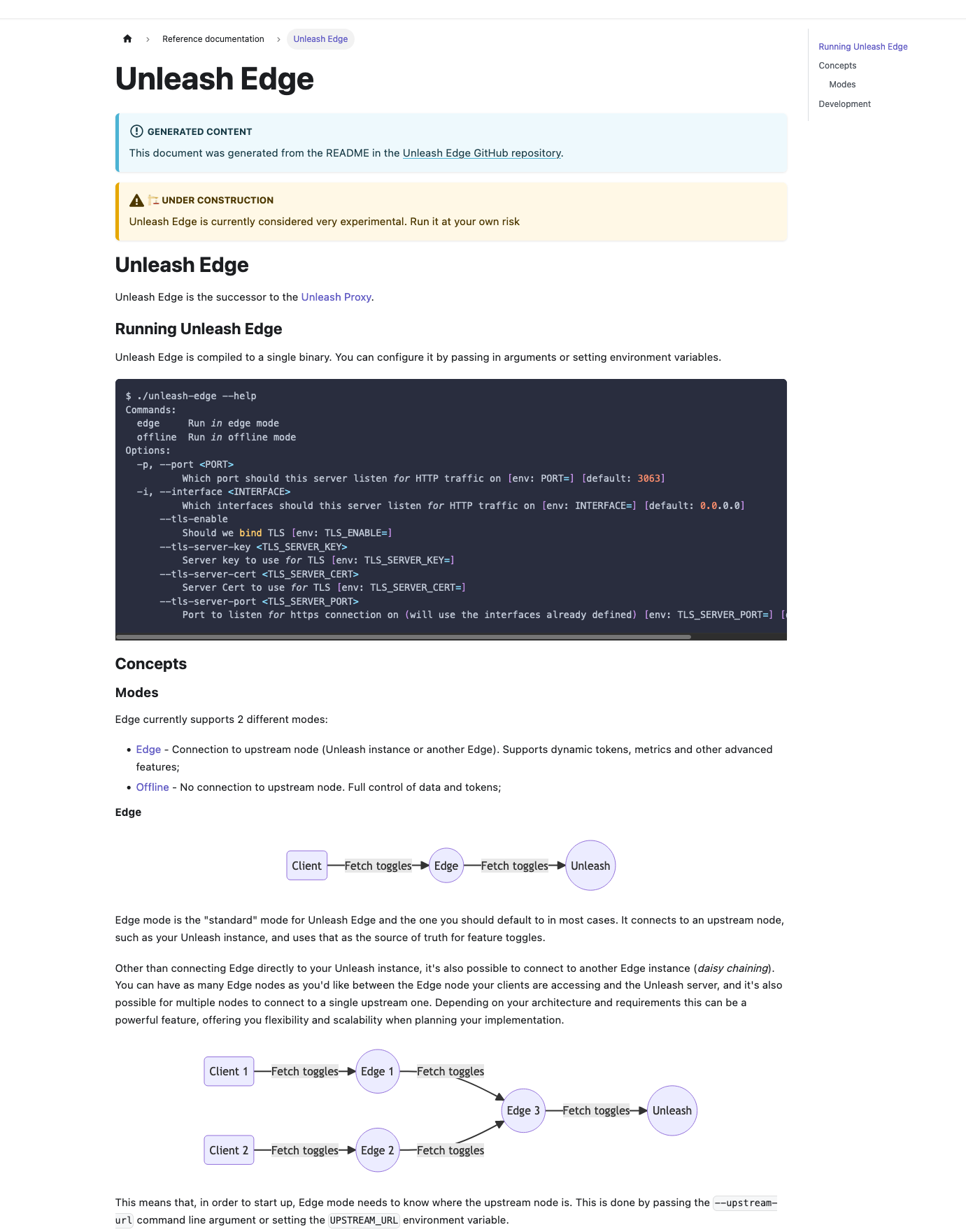## What The main purpose of this PR is to 1. Delete the proxy docs in this repo and replace them with the proxy's GitHub readme. 2. Add the docs for Unleash Edge. ### Detailed change description This PR contains a lot of small changes in a large number of files. To make it easier to get an overview, here's a detailed description of what happens where: #### In the `website/docs`directory Except for the deletion of the proxy doc, all changes in this directory are rewriting internal links, so that they point to the newly generated document instead. #### `package.json` and `yarn.lock` When including the documentation for Edge, we also want to render the mermaid diagrams it uses. Docusaurus supports this via a plugin. All changes in these files are related to installing that plugin. #### `docusaurus.config.js` There's two types of changes in this file: 1. Mermaid-related changes: we ask docusaurus to render mermaid in markdown files and add the plugin 2. Document generation. There's some rewrites to the sdk doc generation plus an entirely new section that generates docs for Edge and the proxy #### `sidebars.js` Two things: 1. Add the edge docs 2. Move both the Edge and the proxy docs up a level, so that they're directly under "reference docs" instead of nested inside "unleash concepts". #### In the `website/remote-content` directory These are the remote content files. Previously, all of this lived only in a `readme-fns.js` file, but with the introduction of Edge and proxy docs, this has been moved into its own directory and refactored into three files (`shared`, `sdks`, `edge-proxy`). #### `custom.css` Style updates to center mermaid diagrams and provide more space around them. #### In `static/img` The image files that were included in the proxy doc and that have been deleted. ## Why For two reasons: 1. Reduce duplication for the proxy. Have one source of truth. 2. Add docs for edge. ## Discussion points and review wishes This is a big PR, and I don't expect anyone to do a line-by-line review of it, nor do I think that is particularly useful. Instead, I'd like to ask reviewers to: 1. Visit the [documentation preview](https://unleash-docs-git-docs-source-proxy-gh-unleash-team.vercel.app/reference/unleash-proxy) and have a look at both the proxy docs and the Edge docs. Potentially have a look at the SDK docs too to verify that everything still works. 2. Consider whether they think moving the proxy and edge docs up a level (in the sidebar) makes sense. 3. Let me know what slug they'd prefer for the Edge docs. I've gone with `unleash-edge` for now (so that it's `docs.getunleash.io/reference/unleash-edge`), but we could potentially also just use `edge`. WDYT? 4. Read through the detailed changes section. 5. Let me know if they have any other concerns or questions. ## Screenies The new proxy doc:  The new edge doc: 
8.3 KiB
| title |
|---|
| Activation Strategies |
It is powerful to be able to turn a feature on and off instantaneously, without redeploying the application. The next level of control comes when you are able to enable a feature for specific users or enable it for a small subset of users. We achieve this level of control with the help of activation strategies. The most straightforward strategy is the standard strategy, which basically means that the feature should be enabled to everyone.
Unleash comes with a number of built-in strategies (described below) and also lets you add your own custom activation strategies if you need more control. However, while activation strategies are defined on the server, the server does not implement the strategies. Instead, activation strategy implementation is done client-side. This means that it is the client that decides whether a feature should be enabled or not.
All server-side client SDKs and the Unleash Proxy implement the default strategies (and allow you to add your own custom strategy implementations). The front-end client SDKs do not do the evaluation themselves, instead relying on the Unleash Proxy to take care of the implementation and evaluation.
Some activation strategies require the client to provide the current Unleash context to the toggle evaluation function for the evaluation to be done correctly.
The following activation strategies are bundled with Unleash and always available:
Standard
A basic strategy that means "active for everyone".
This strategy has the following modelling name in the code:
- default
UserIDs
Active for users with a userId defined in the userIds list. A typical use case is to enable a feature for a few specific devs or key persons before enabling the feature for everyone else. This strategy allows you to specify a list of user IDs that you want to expose the new feature for. (A user id may, of course, be an email if that is more appropriate in your system.)
Parameters
- userIds - List of user IDs you want the feature toggle to be enabled for
This strategy has the following modelling name in the code:
- userWithId
Gradual Rollout
A flexible rollout strategy which combines all gradual rollout strategies in to a single strategy. This strategy allows you to customize what parameter should be sticky, and defaults to userId or sessionId.
Parameters
- stickiness is used to define how we guarantee consistency for a gradual rollout. The same userId and the same rollout percentage should give predictable results. Configuration that should be supported:
- default - Unleash chooses the first value present on the context in defined order userId, sessionId, random.
- userId - guaranteed to be sticky on userId. If userId not present the behavior would be false
- sessionId - guaranteed to be sticky on sessionId. If sessionId not present the behavior would be false.
- random - no stickiness guaranteed. For every isEnabled call it will yield a random true/false based on the selected rollout percentage.
- groupId is used to ensure that different toggles will hash differently for the same user. The groupId defaults to feature toggle name, but the user can override it to correlate rollout of multiple feature toggles.
- rollout The percentage (0-100) you want to enable the feature toggle for.
This strategy has the following modelling name in the code:
- flexibleRollout
Custom stickiness (beta)
:::note This feature is currently in beta and is not yet supported by all our SDKs. Check out the SDK compatibility table to see what SDKs support it at the moment.
:::
By enabling the stickiness option on a custom context field you can use the custom context field to group users with the gradual rollout strategy. This will guarantee a consistent behavior for specific values of this context field.
IPs
The remote address strategy activates a feature toggle for remote addresses defined in the IP list. We occasionally use this strategy to enable a feature only for IPs in our office network.
Parameters
- IPs - List of IPs to enable the feature for.
This strategy has the following modelling name in the code:
- remoteAddress
Hostnames
The application hostname strategy activates a feature toggle for client instances with a hostName in the hostNames list.
Parameters
- hostNames - List of hostnames to enable the feature toggle for.
This strategy has the following modelling name in the code:
- applicationHostname
Multiple activation strategies
You can apply as many activation strategies to a toggle as you want. When a toggle has multiple strategies, Unleash will check each strategy in isolation. If any one of the strategies would enable the toggle for the current user, then the toggle is enabled.
As an example, consider a case where you want to roll a feature out to 75% of your users. However, you also want to make sure that you and your product lead get access to the feature. To achieve this, you would apply a gradual rollout strategy and set it to 75%. Additionally, you would add a user IDs strategy and add engineer@mycompany.com and productlead@mycompany.com.
Deprecated strategies
gradualRolloutUserId (DEPRECATED from v4) - Use Gradual rollout instead
The gradualRolloutUserId strategy gradually activates a feature toggle for logged-in users. Stickiness is based on the user ID. The strategy guarantees that the same user gets the same experience every time across devices. It also assures that a user which is among the first 10% will also be among the first 20% of the users. That way, we ensure the users get the same experience, even if we gradually increase the number of users exposed to a particular feature. To achieve this, we hash the user ID and normalize the hash value to a number between 1 and 100 with a simple modulo operator.
Starting from v3.x all clients should use the 32-bit MurmurHash3 algorithm to normalize values. (issue 247)
Parameters
- percentage - The percentage (0-100) you want to enable the feature toggle for.
- groupId - Used to define an activation group, which allows you to correlate rollout across feature toggles.
gradualRolloutSessionId (DEPRECATED from v4) - Use Gradual rollout instead
Similar to gradualRolloutUserId strategy, this strategy gradually activates a feature toggle, with the exception being that the stickiness is based on the session IDs. This makes it possible to target all users (not just logged-in users), guaranteeing that a user will get the same experience within a session.
Parameters
- percentage - The percentage (0-100) you want to enable the feature toggle for.
- groupId - Used to define an activation group, which allows you to correlate rollout across feature toggles.
gradualRolloutRandom (DEPRECATED from v4) - Use Gradual rollout instead
The gradualRolloutRandom strategy randomly activates a feature toggle and has no stickiness. We have found this rollout strategy very useful in some scenarios, especially when we enable a feature which is not visible to the user. It is also the strategy we use to sample metrics and error reports.
Parameters
- percentage - The percentage (0-100) you want to enable the feature toggle for.

